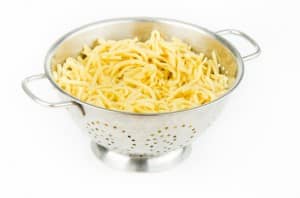 Molecules:
Molecules:
The term “hard” floor maintenance is misleading when you take a closer look at the molecule makeup of the floor. Whether it is vinyl composition tile (VCT), terrazzo, concrete, ceramic tile, or synthetic every type of flooring is porous. Those pores act like a colander: water and soil drain right through the holes. Unlike the boiling pan of pasta you pour into that colander, however, the water and soil don’t drain away. In fact, the pores in the floor attract and contain that soil resulting in a dull, speckled, or dirty looking floor.
Floor seals are designed to close the gap. Whether the seal is a urethane or a polymer blend, the molecules are larger than the pores in the floor thus providing a water resistant barrier against soil. (BTW – The same gap sealing action takes place during concrete polishing which includes hardening and sealing the floor as part of the polishing process.) Why is this important? Sealing the pores allows for easy soil removal because the dirt remains on the surface.
Solids:
The quality of a seal or wax is often measured in terms of solids that remain after evaporation, otherwise known as the drying process. Typical solid content ranges from 20-22% which means only one-fifth of what you apply to the floor will remain once it dries. A high solids wax or seal will contain as much as 25% (one-quarter) solid content. The rule of thumb when applying wax is to leave the equivalent of 100% solids left on the floor when you finish, so depending upon what type of finish is being used 100% is equal to 4-5 coats.
Burnishing:
There are two terms in floor maintenance that are seemingly interchangeable: burnishing and buffing. These two words could not be more opposite. A high speed burnisher is a walk behind machine that operates at 1500 RPM’s or higher. Unlike a buffer, the wheels of a burnisher are in constant contact with the floor, preventing it from swinging back and forth. Although it operates at higher speeds, a burnishing machine is much easier to operate than a buffer that typically runs at only 175 RPM’s.
If you choose to apply a floor finish that requires burnishing keep in mind it will need burnished on a consistent if not daily basis. Burnishing reheats the wax or seal, removing scratches and imperfections within the finish. It is an excellent way to keep your floors looking glossy, but if you are not prepared to spend that much time and labor maintaining your floor then you will want to choose a different style finish. In contrast, buffing is a restorative process for the non-burnished floor; it requires the use of a mop-on restorer that acts as a filler agent.
Cleaner:
Every floor, regardless of whether it is sealed and finished, should be cleaned on a daily basis. Most waxes are water-resistant but no wax is water-proof, so remove water as soon as possible. If water is allowed to dwell upon the surface it will eventually eat away at even the toughest finish. Soil and dirt should also be removed on a daily basis by using a neutral floor cleaner which is effective on all floor types including polished concrete. (Depending upon the soil type a degreaser may also be required.)





